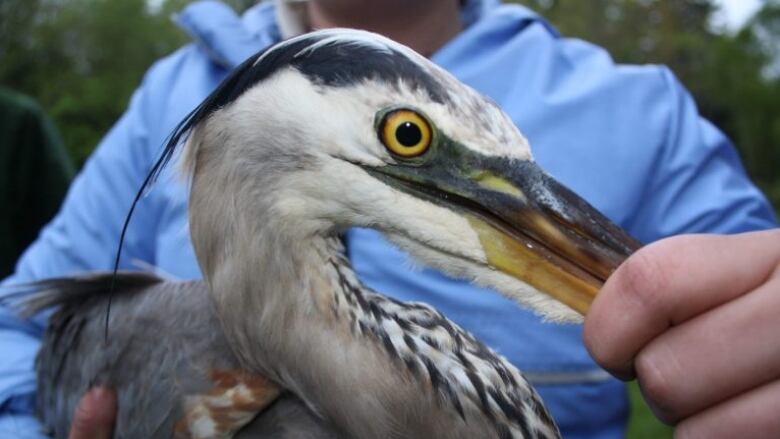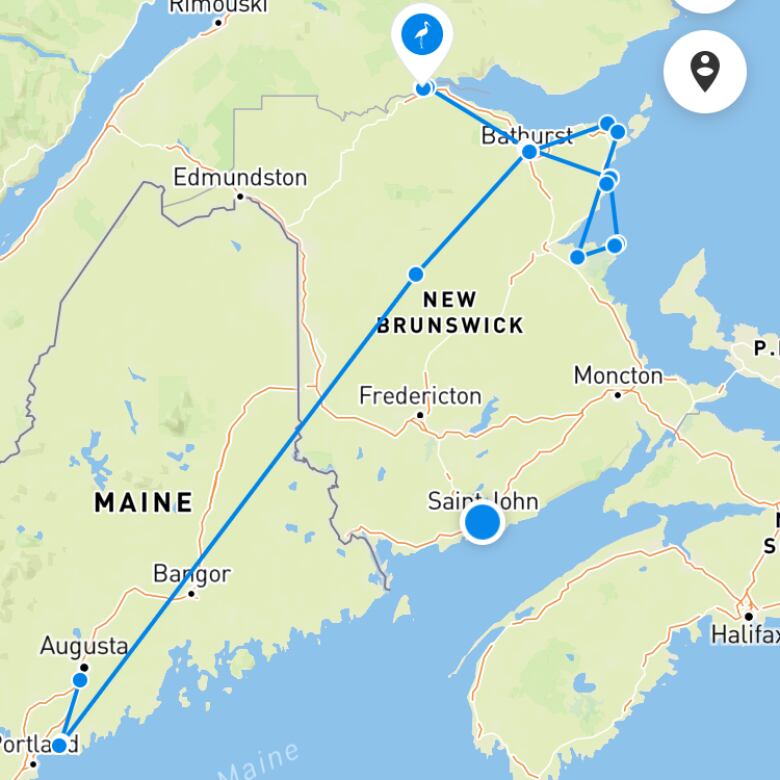When fall rolls around, Harper the heron shows off her feats of strength
Great blue heron summers in New Brunswick, dazzles researchers with her migrations each fall

Harper the great blue heron is full of surprises.
Ever since she was first tagged with a GPS tracker in May2019, the bird has been throwing researchers curveballs.
She was caught late in the nesting season near Harpswell, Maine, a coastal community not far from Freeport.
Danielle D'Auria, a wildlife biologist with the Maine Department of Inland Fisheries and Wildlife who is studying why coastal populations of herons are in decline there, said they had hoped she was part of a colony in Maine and was either too young or too old to nest.
That's when Harper gave researchers their first surprise.
She immediately headed north to New Brunswick, first to Bathurst, then the Acadian Peninsula, Miramichi and finally back to Bay of Chaleur.

"My theory is that she's prospecting, so kind of looking for a place to nest maybe next year," D'Auria said to CBC at the time.
When fall rolled around last year, Harper began her migration south, and that's when she showed off how remarkable she was.
Her last stop in the province was in Saint John, and D'Auria said from there she headed out over the ocean.
"And in 38 hours, non-stop over the Atlantic Ocean and first landfall was in Nocatee, Fla., 38 hours later," D'Auria said in an interview this week by phone, "So we were very impressed by her non-stop flight and she went over the open ocean."
That's more than 1,500 kilometres.

D'Auria admits the sample size is small, but the six or seven other birds whose migration paths they tracked behaved very differently from Harper
"And a lot of other birds have kind of hugged the coast a little more and even stopped several times along the way."
Impressive as her flight was, Harper had an even more awe-inspiring feat in store for researchers this year.
After returning to New Brunswick, where D'Auria believes Harper was nesting, based on her spring activity, and then spending the summer here, the heron left for warmer climes on Oct. 8.
"This one I wasn't expecting this," D'Auria said, "I thought last year might have been an anomaly and might have just been based on some crazy wind conditions."

Harper took off from the Quebec side of Bay of Chaleur, and headed far out to sea.
D'Auria said the bird made a long arc over the Atlantic, passing near Bermuda, likely about 900 kilometres off the coast of North Carolina.
Harper finally set down in southern Georgia, after a non-stop flight that lasted 68 hours.
But why did she do it?
Likely following the wind
D'Auria doesn't believe the heron was avoiding bad weather. In fact, she's pretty sure Harper was taking advantage of the weather.
"Well, I did look up some weather maps where you can see kind of the prevailing winds on the different days that she was flying and where she was along her path," D'Auria said.
"And it's consistent with the direction that she was flying with the wind. The wind directions were kind of going in the same direction that she was headed. So I think she's taking advantage of those patterns."
D'Auria said altitude estimates from the GPS tracker also suggest winds were a factor.
"She was averaging about 750 feet or so above the ocean. And then the maximum that was recorded on that flight was about 4,100."
More feats in store?
D'Auria said winds can definitely be more favourable at higher altitudes.
While this study is an effort to learn more about why Maine's coastal colonies of great blue herons are in decline, D'Auria said what they're learning about migration patterns is a nice bonus.
"The migration information that we've been gaining is kind of extra, but also really valuable because a lot of this stuff is new. A lot of the information is new and has never been documented before."
And maybe Harper has a few more surprises in store for the people following her travels.
You can access that data through the Heron Observation Network of Maine on its Facebook page.












_(720p).jpg)


 OFFICIAL HD MUSIC VIDEO.jpg)
.jpg)



























































































